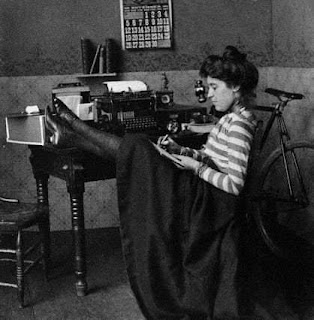To Find the Heart of Your Story, Try This
 |
| Woman Writes in 1901. (Bettmann / Getty) |
Long, long time ago and in a galaxy far, far away, it was the time before computers. The public library was way, way on the other side of town. There were no bookstores. The only library available to me was my school library. I checked out every book I could read. By fourth grade, my favorite authors were already Mark Twain, Jack London, Charles Dickens, James Fennimore Cooper, Tolkien’s The Hobbit, and many more. And if I wanted to have my very own copy of a book, and not have to return it, I copied the book.
By hand.
Even now, after all these decades, with the onslaught of computers, iPads and
fancy programs that write stories for you, I still write everything by hand. Even
this article was first written by hand.
It turns out to be a good thing, to write by hand. Scientists now know that
cursive writing is an important tool for cognitive development. It teaches the
brain to be efficient, helps to develop critical thinking skills and refines
motor control. In fact, children who learn cursive tend to learn how to read
faster, generate more ideas and retain more information.
When I was copying my books in the fourth grade, I paid more attention to the
details of the story. I experienced the characters on a deeper level because
the very act of writing them out engaged all my senses. I had to pay attention
to the words, how they were ordered, and how they were used. And, of course, I experienced
the logical chain of events.
If you want to experience the emotive core, and follow the
logic, of your story, write the first draft by hand. And, perhaps the first
revision, too.
As William Klemm PhD noted, “There is a spill-over benefit
for thinking skills used in reading and writing. To write legible cursive, fine
motor control is needed over the fingers. You have to pay attention and think about
what and how you are doing it. You have to practice. Brain imaging studies show
that cursive activates areas of the brain that do not participate in
keyboarding…
Much of the benefit of handwriting, in general, comes simply
from the self-generated mechanics of drawing letters.”
The quantity of words becomes less important than the quality of words. Joyce Carol Oates, on writing her stories by longhand, including an 800-page one, states: “Productivity is a relative matter. And it’s really insignificant...
"What is ultimately important is a writer’s strongest books. It
may be the case that we all must write many books in order to achieve a few
lasting ones — just as a young writer or poet might have to write hundreds of
poems before writing his first significant one. Each book as it is written,
however, is a completely absorbing experience, and feels always as if it
were the work I was born to write.”
In an interview by Buzzfeed writer Hayley Campbell, Neil Gaiman describes how he started writing his novels longhand in the '90s: "I started with Stardust: It was (in my head) being written in the 1920s, so I bought a fountain pen and a big notebook and wrote it by hand to find out how writing by hand changed my head." Candid about the details of his writing process, Gaiman has a collection of over sixty fountain pens:
“Working in fountain pen is good because it slows me down just enough to keep my handwriting legible. Often I use two pens with different colored ink, so I can tell visually how much I did each day.”
You might be interested to see more:
Campbell, Hayley. “This Is What A Handwritten Novel By Neil Gaiman Looks Like”. Buzzfeed, Dec. 4, 2015.
Cameron, Julia. "Morning Pages: why by hand?. The Artist’s Way".
October 4, 2012
Klemm, William. “Why Writing by Hand Could Make You Smarter”. Psychology
Today. March 14, 2013.
Prevost, Chad. “8 Legendary Authors You Wouldn’t Believe Write in Longhand”. June 14, 2021.
-- Bobbi Miller
This is fascinating. I do a ton of outlining / planning / brainstorming by hand.
ReplyDeleteHi Holly, and I do all my planning by hand, too! My notetaking, outlining. I even revise my outline by hand. I tried some of the online counterparts, like Scrivener. I found it too frustrating. Eegads!
DeleteSo there is another member of my first-draft-in-long hand club! Can't create as well without notebooks, legal pads, lots of mechanical pencils...
ReplyDeleteEXACTLY, Darlene! And postnotes! Must have postnotes!
Delete